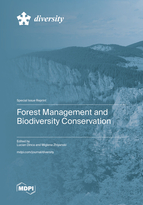Plant Species Turnover on Forest Gaps after Natural Disturbances in the Dinaric Fir Beech Forests (Omphalodo-Fagetum sylvaticae)
Round 1
Reviewer 1 Report
The authors should consider in Methods, add reference in line 192 that allows the explanation of the characteristics "...diagnostic, constant and dominant … "
for ex. Ivan Jarolímek; et al (2008)
https://www.worldcat.org/title/diagnostic-constant-and-dominant-species-of-the-higher-vegetation-units-of-slovakia/oclc/1040415321
Some typography mistakes:
line 19: in abstract, "(have a higher continentality." close parentheses
line 468: "...the remaining forest understorey...", understory
"...a older..." an older
Format for ref. 65 (lines 612-613).
Author Response
Dear reviewer,
thank you for your constructive comments.
Best wishes, authors
Reviewer 2 Report
Review of the paper „Plant species turnover on forest gaps after natural disturbances in the Dinaric fir beech forests (Omphalodo-Fagetum sylvaticae)”
The article concerns the floristic diversity and the succession of plants in natural forest gaps resulting from reasons such as the fall of an old tree. It may seem that the number of sites is relatively small to conclude, but it was certainly not easy to find various natural forest gaps suitable for observation in similar years. I appreciate the substantive preparation of the authors visible in the discussion (this is the best part of the manuscript). Nevertheless, I believe that the article needs improvement mainly due to the often unfortunate wording and the lack of clear conclusions. Suggestions for the manuscript are provided below.
Abstract. L16 – typical representatives – „representatives” seem to be enough, these are typical individuals by definition. L17 – Illyrian floristic element – not clear at the stage of Abstract (be more specific). L19 – something is missing. L20 – is your paper define a particular plant community of forest gaps? L21-22 – should be corrected and rephrased.
Introduction. L27 – not caused, rather shaped, created or formatted. The manuscript is full of unfortunate wording, an example is L28 "normal part" – it should be a standard stage, typical stage or other similar substantive wording. I suggest you check the entire text in this regard. L30-L31 – please, correct and rephrase. L40 – not surface area, but rather decide whether to use surface or area. There are so many similar comments to the text that from now on I will list them selectively because I am not able to do otherwise. Lines 41-42 – double “also” in a single sentence. Line 43 – also again; in this case write rather about the compact (not closed) forest. Line 45 – should be without “in terms of humidity”. In general, I believe that the introduction is substantively justified, but written in a chaotic manner. I suggest rebuilding this chapter according to the points: 1. Definition of gaps and describing what physical conditions change after the formation of a new gap. 2. Floristic description of gaps in relation to the existing plant communities typical for the forest, emphasizing that some species do not change or adapt (and in what way), as well as new plants appear. 3. Description of the seed bank aspect and mechanisms of changes in plant species composition in gaps. I also suggest presenting the hypotheses in the form of points.
Materials and Methods. L116 – „very diverse mosaic of soil types which change on relatively small distances” – please, rephrase. It will be enough “diverse soils changing in a small scale”. There are several similar sentences in this chapter that need to be corrected and simplified. L123 – there should be a new paragraph. L141-144 – I am not sure if this way of determining the age of gaps is sufficient, please provide citations that defined the age in a similar way. Perhaps it would be more rational to determine the stage of development of particular annuals, biennials and perennials during the first visit in forest gaps? There is also no information on how it was determined whether the gaps were formed naturally, and not, for example, as a result of a lightning. Floristic survey and sampling, as well as data analysis, seem reasonable.
Results. L208-210 – please, remove. Figure 2 – in this chapter, it would be useful to have brief information on whether the similarities and differences between forest gaps are related to their spatial distribution, or they result from the conditions in a given location. Table 5 – there is no information about the choice of species for this table – whether it applied to a specific percentage range, or was it supposed to be "top 5?" in both cases. This chapter is rather difficult to read – I suggest identifying individual study sites with constant letters or numbers according to the key chosen by the authors resulting e.g. from the age of gaps or some ecological features, and then describing the gaps without repeated local names. Lines 306-322 – instead of describing the measurement results, I suggest a comparative way of writing, i.e. compare individual gaps, use the words "more, less, some per cent more, etc.". Figure 4 – too little informative; if the authors had chosen to name sites either alphabetically or numerically, e.g. according to the age of gaps, this chart would be readable.
Discussion. L330-331 – readers won't know what alpha and beta diversity are, because they didn't know it from the previous part of this article. I believe that the discussion is the best part of the article, excluding the fact that the authors discuss locations known only for them, which is not informative for the readers. I suggest naming sites differently, preferably according to age or size of gaps. There are no conclusions in the article.
Author Response
Dear reviewer,
thank you for your constructive comments. We agreed with them and we hope that we corrected the manuscript according to them.
Best wishes, authors
Author Response File: ![]() Author Response.pdf
Author Response.pdf





